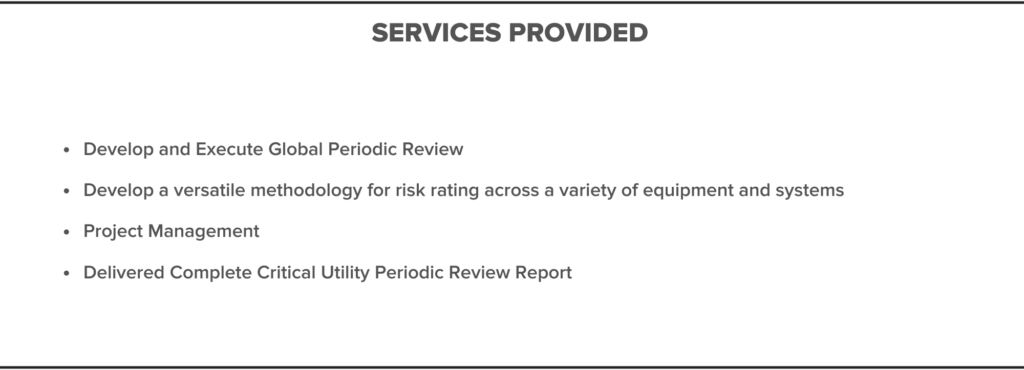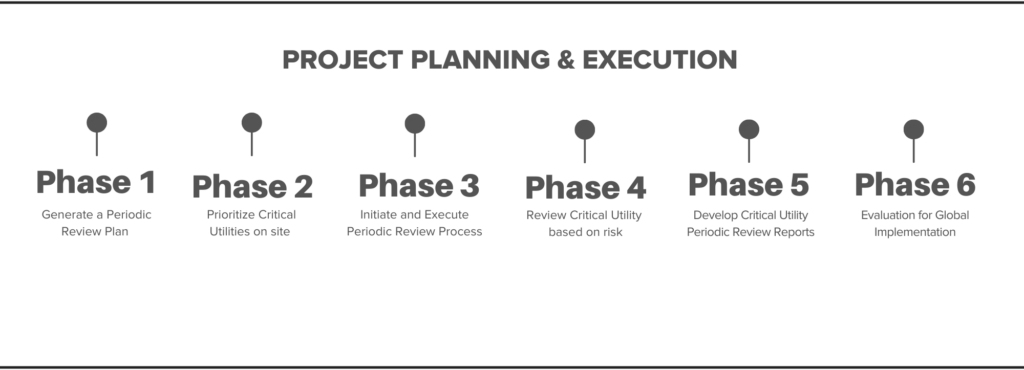At A Glance
A prominent pharmaceutical manufacturer on a global scale was seeking to integrate periodic reviews in their quality process to detect qualification gaps, undocumented system modifications, deviation trends, as well as maintenance and calibration issues, negative trends in system performance, and inadequacies in the development of required legacy documents. In collaboration with the company’s Process Analytical Lifecycle Management (PALM) team, Performance Validation (PV) devised a comprehensive periodic review plan that could be implemented across multiple departments throughout the site. By leveraging this plan, PV successfully produced the initial ten (10) Critical Utility Periodic Review Reports, prioritized by system risk rating.

Periodic Review Plan Outlined to Prioritize Client’s Critical Utilities
The Performance Validation team initiated the process of the Periodic Review Plan, which outlines the criteria employed for the prioritized evaluation of critical utilities on site, as well as the content requirements for each system’s Periodic Review Report. The prioritization level of each system’s periodic review was determined by subject matter experts based on five predetermined attributes and assigned a score value. The score of each attribute category was aggregated, and the systems with the highest total score were assigned the highest priority. Subsequently, further prioritization, if required, was based on SME input.
The review of critical utility systems was conducted based on risk, and priorities were determined on various factors such as the proximity of utilities to finished products, the complexity of utilities, the number of quality and reliability issues such as deviations and unscheduled maintenance, and the length of time the utility had been in operation. This prioritization approach ensured that the highest priority was given to the utilities that posed the most significant risk.
The Periodic Review Plan was subjected to review, discussion, and approval by the key stakeholders associated with the project. Following the Periodic Review Plan’s approval, Performance Validation developed the first ten (10) Critical Utility Periodic Review Reports, which were subjected to assessment by the project team. After each utility review, non-critical action items went on the site risk register which is reviewed monthly by quality and the system owner and addressed as production and budget allows. Critical action items were assigned a CAPA with a 6-month resolution period.

Critical Utilities Periodic Review Report Implemented to Global Sites
Performance Validation played a pivotal role in facilitating the design and approval of the Periodic Review Plan at the designated site, which was subsequently evaluated for potential global implementation by the company. By leveraging constant communication and meetings with various system owners, subject matter experts, quality assurance, maintenance, and validation personnel, Performance Validation generated the first ten (10) highest-priority Critical Utilities Periodic Review Reports at the site. This exercise led to the identification of negative trends, gaps in legacy documentation and qualification, and consequently, the formulation of key system improvement recommendations by PV. These recommendations were endorsed by the company project team and subsequently implemented to ensure each Critical Utility was in a state of control, as mandated by the regulatory framework.
WE TURN CRITICAL INTO COMPLIANT
Since 1988, our team at Performance Validation has been professionally validating, commissioning, and qualifying service areas in federally regulated industries. Our expert team focuses on integrity, quality, and teamwork in every project, giving our clients the peace of mind they deserve during each project.


